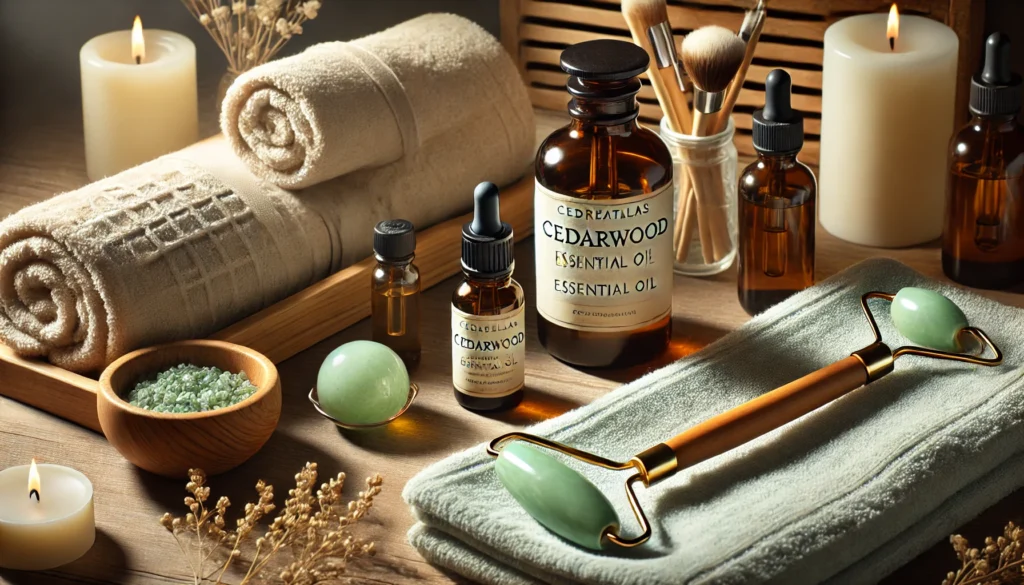Introduction
Clear and glowing skin is something many people strive for, but achieving it can often feel like an uphill battle. From acne to dullness, the skin faces numerous challenges, especially when exposed to environmental factors, stress, and hormonal imbalances. While there are countless skincare products on the market, many contain harsh chemicals that may do more harm than good in the long run. Fortunately, nature provides a solution—cedarwood essential oil. This powerful oil has been used for centuries due to its antiseptic, regenerative, and soothing properties, making it a must-have for anyone seeking radiant skin.
In this article, we’ll dive into how cedarwood oil can benefit your skincare routine, the science behind its properties, and how you can use it to achieve clearer, more vibrant skin.

What is Cedarwood Essential Oil?
Cedarwood essential oil is derived from the wood, needles, and bark of cedar trees. It has a warm, woody scent and is packed with properties that are not only beneficial for health and wellness but also highly effective in skincare. Known for its antiseptic, anti-inflammatory, and regenerative effects, cedarwood oil has been used in traditional medicine for centuries.
For skincare, cedarwood essential oil can help balance oil production, soothe irritation, and reduce the appearance of acne and scars, promoting clearer and more youthful skin. It’s especially beneficial for those dealing with conditions such as acne, eczema, or psoriasis, but it can also be used by anyone looking to enhance their natural glow.
The Benefits of Cedarwood Essential Oil for Skincare
1. Antiseptic Properties for Acne Control
Acne is one of the most common skin concerns, particularly among teenagers and adults. It’s caused when hair follicles become clogged with oil, dirt, and dead skin cells, leading to inflammation and bacterial growth. The antiseptic properties of cedarwood essential oil make it an excellent natural remedy for combating acne.
- How it works: Cedarwood oil helps cleanse the skin, removing bacteria and preventing the spread of acne-causing germs. It also helps balance oil production, reducing the likelihood of clogged pores and future breakouts.
- Tip for use: Add a few drops of cedarwood oil to a carrier oil like jojoba or almond oil and apply it to the affected areas after cleansing.
2. Regenerative Power for Skin Renewal
One of the lesser-known yet highly beneficial properties of cedarwood essential oil is its ability to regenerate skin cells. This makes it effective in healing scars, blemishes, and hyperpigmentation.
- How it works: Cedarwood oil promotes cell regeneration and turnover, helping to fade scars and brighten dull skin. This regenerative ability supports the skin’s natural healing process and encourages a more youthful appearance.
- Tip for use: Combine a few drops of cedarwood oil with rosehip oil, which is known for its scar-healing properties, and gently massage it onto areas with scarring or dark spots.
3. Anti-Inflammatory Effects to Soothe Irritated Skin
Skin irritation can manifest in various forms, from redness and itching to conditions like eczema. Cedarwood oil’s anti-inflammatory properties can provide relief by calming irritated skin and reducing redness.
- How it works: The soothing effect of cedarwood essential oil reduces inflammation and discomfort in conditions like eczema, dermatitis, and even insect bites.
- Tip for use: Create a soothing balm by mixing cedarwood oil with shea butter or coconut oil and applying it to inflamed or irritated skin.
4. Balancing Oil Production for Combination Skin
For those with combination or oily skin, cedarwood oil can help balance sebum production. Overactive oil glands can lead to greasy skin, clogged pores, and eventually breakouts, but cedarwood oil can regulate these processes.
- How it works: By balancing sebum production, cedarwood oil prevents excess oiliness while maintaining proper hydration levels. This ensures that your skin stays moisturized without becoming overly greasy.
- Tip for use: Mix cedarwood oil into your daily moisturizer or serum to help regulate oil production without drying out your skin.

How to Use Cedarwood Essential Oil for Your Skincare Routine
Integrating cedarwood essential oil into your skincare routine is easy, and with consistent use, you can reap its benefits for clear, radiant skin. Here are some ways you can incorporate this natural remedy into your daily regimen:
1. As a Spot Treatment for Acne
Cedarwood oil can be an effective spot treatment for acne-prone areas. Its antiseptic and anti-inflammatory properties make it ideal for reducing pimples and soothing the skin.
- How to use: Dilute 2-3 drops of cedarwood oil in a teaspoon of a carrier oil (such as jojoba or argan oil) and apply directly to blemishes using a cotton swab.
2. Add It to Your Facial Cleanser
You can enhance the cleansing power of your daily face wash by adding a couple of drops of cedarwood oil. This will help eliminate bacteria and prevent acne breakouts.
- How to use: Mix 2-3 drops of cedarwood oil into your regular cleanser and gently massage it onto your face. Rinse with warm water and pat your skin dry.
3. Make a Hydrating Face Mask
Cedarwood oil can be combined with other natural ingredients to create a hydrating and acne-fighting face mask. This can help soothe inflamed skin and balance oil production.
- How to use: Mix 1 tablespoon of honey, 2 teaspoons of yogurt, and 3 drops of cedarwood oil. Apply the mask evenly to your face and leave it on for 15-20 minutes before rinsing off.
4. Use in a DIY Facial Toner
Toners help balance the skin’s pH levels and remove any remaining impurities after cleansing. You can create your own natural toner using cedarwood oil.
- How to use: Combine 1 cup of distilled water, 1 tablespoon of witch hazel, and 5 drops of cedarwood essential oil in a spray bottle. Shake well and spray it onto a cotton pad, then gently wipe it across your face after cleansing.
5. As an Overnight Treatment for Scarring
To target scars and dark spots, you can use cedarwood oil as an overnight treatment. Its regenerative properties will work to heal your skin while you sleep.
- How to use: Dilute 3-4 drops of cedarwood oil in 1 teaspoon of rosehip oil or argan oil. Massage it onto areas with scarring or hyperpigmentation before going to bed.

Safety Considerations When Using Cedarwood Essential Oil
While cedarwood oil is generally safe for use, there are a few important precautions to keep in mind to ensure you’re using it correctly and effectively:
- Always dilute: Cedarwood oil should be diluted with a carrier oil before being applied to the skin. Applying it directly can cause irritation, especially for those with sensitive skin.
- Patch test first: Before using cedarwood oil on your face or body, do a patch test on a small area of your skin to check for any allergic reactions or sensitivity.
- Avoid sensitive areas: Cedarwood oil should not be applied near the eyes or other sensitive areas.
- Consult a doctor if pregnant: If you’re pregnant or breastfeeding, consult with your healthcare provider before using cedarwood essential oil, as some essential oils may not be recommended during this time.

Conclusion: Embrace Nature for Radiant, Healthy Skin
Cedarwood essential oil is a versatile and powerful tool in the journey to clearer, more radiant skin. Whether you’re dealing with acne, scarring, or simply looking to rejuvenate your complexion, its antiseptic, regenerative, and anti-inflammatory properties make it a must-have in any natural skincare routine.
By incorporating cedarwood oil into your daily regimen, you can achieve a balanced and glowing complexion without relying on harsh chemicals. Remember to use it consistently and safely to unlock the full potential of this natural remedy.
Ready to transform your skincare routine? Start by adding cedarwood essential oil to your daily regimen and experience the difference it can make for your skin! Share your results and skincare tips with us in the comments below.


